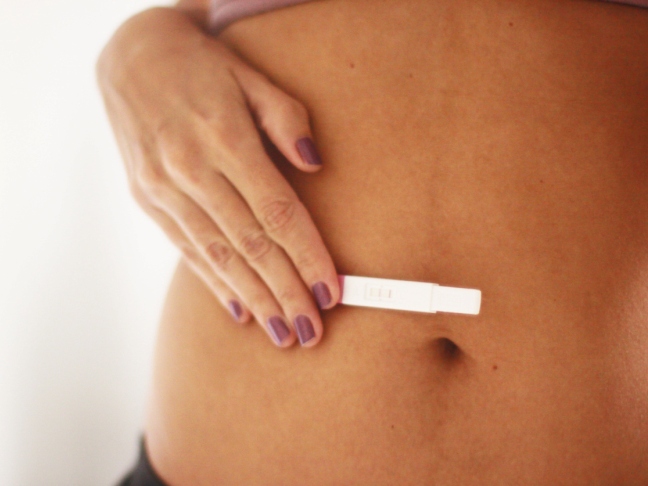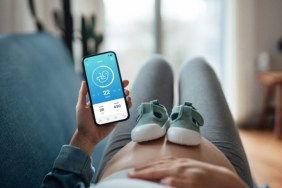When you’re ready to start trying, the word “test” quickly works its way into your daily vocabulary. If you’re not taking pregnancy tests, you’re taking ovulation tests—and your emotions are tested to the max. Ovulation indicates your fertile time of the month; these are the days when you should be trying to conceive.
Suddenly, kits, sticks, and monitors hold the answers for your hopes for the future. But, don’t let them overwhelm you! Know how and when to use these at-home ovulation checkers and get in tune with your body’s rhythm to find out when you’re most fertile.
Calendar or Rhythm Method
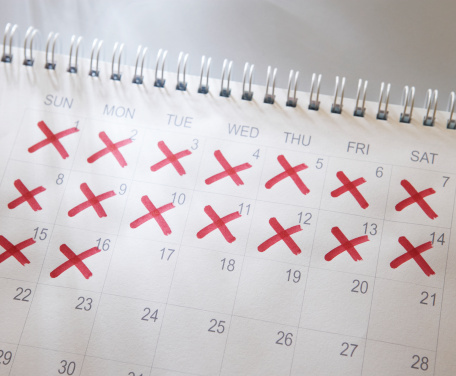 “Women with regular cycles almost always ovulate 14 days before their next period,” says Alan Copperman, MD, director of infertility and vice chairman of the department of obstetrics, gynecology, and reproductive science at Mount Sinai Medical Center, in New York City.
“Women with regular cycles almost always ovulate 14 days before their next period,” says Alan Copperman, MD, director of infertility and vice chairman of the department of obstetrics, gynecology, and reproductive science at Mount Sinai Medical Center, in New York City.
Unfortunately, it’s not so straighfoward! The normal 28-day menstrual cycle (which starts with the first day of your period and extends to Day 1 of your next period) can vary between 23 and 35 days, depending on the month, your stress levels, your routine, and a variety of other factors. So, how can you count on the Calendar Method when your period is irregular?
To determine when you’re most fertile, do this:
- track your menstruation on a calendar for six months
- subtract 18 days from your shortest menstrual cycle
- subtract 11 days from your longest cycle
The timeframe in between is when you’re more likely to get pregnant!
Basal Body Temperature Readings (BBT)
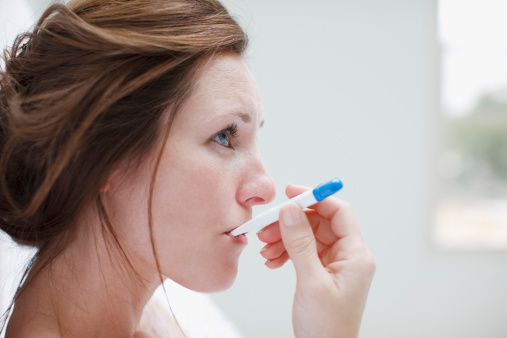 Your body gets fired up when you want to turn up the heat in the bedroom. Well, sort of—your temperature is likely slightly higher after you ovulate (we’re talking less than a degree for three days or more). That’s right, we said AFTER ovulation, because you’re most fertile the two to three days beforehand, but your man’s sperm is up to the challenge of fighting time and can survive inside you for up to five days. So, while you may have seen more than one movie where an actress checked her temperature and frantically called her husband to get home for some baby-making, the truth is that it’s not an effective tool for discerning when it’s best to try to conceive.
Your body gets fired up when you want to turn up the heat in the bedroom. Well, sort of—your temperature is likely slightly higher after you ovulate (we’re talking less than a degree for three days or more). That’s right, we said AFTER ovulation, because you’re most fertile the two to three days beforehand, but your man’s sperm is up to the challenge of fighting time and can survive inside you for up to five days. So, while you may have seen more than one movie where an actress checked her temperature and frantically called her husband to get home for some baby-making, the truth is that it’s not an effective tool for discerning when it’s best to try to conceive.
The best time: right before ovulation. An ideal scenario for coneption is when sperm is present inside a woman’s body before a the body releases an egg, says Dr. Copperman. An egg needs to be fertilized within a day of ovulation. “One of the problems with BBT is by the time the temperature goes up and both partners are able to be together, it may be too late [to get pregnant].” He adds: “When trying to conceive, we usually recommend having intercourse every other day starting day 10 or so [in your cycle]. The BBT is [therefore] more useful for information than for [precise] timing.”
So, how to use your temperature to detect ovulation? For best results, take your temperature every day in the morning. For most accurate results you must:
- use a Basal Body Thermometer (a regular thermometer will not read your precise temperature). You need a thermometer that is accurate to 1/10th of a degree, so you might want to buy a BBT thermometer.
- take your temperature first thing in the morning—before getting out of bed, and note it on a graph immediately. Keep in mind that “drinking hot or cold liquids or even brushing teeth before taking [your] temperature can alter a reading,” explains Dr. Copperman. Varying work schedules, fever, and restless sleep may also affect readings, according to the American College of Obstetricians and Gynecologists (ACOG).
Track your cycle this way for a period of months. Remember: you know that your temperature rises immediately after ovulation. Once you start to learn your body’s rythm, you will be able to better predict when ovulation will occur.
Cervical Mucus Method
 Warning! This method is for those who are very comfortable with their bodies. The Cervical Mucus Method (also known as the Billings Method or the Ovulation Method) will certainly help you get in tune with your body, and your observation skills will be put to the test!
Warning! This method is for those who are very comfortable with their bodies. The Cervical Mucus Method (also known as the Billings Method or the Ovulation Method) will certainly help you get in tune with your body, and your observation skills will be put to the test!
You may not have realized this before (but you will now!): the consistency of your vaginal discharge varies during your menstrual cycle. While your vagina is probably driest immediately after your period, the discharge or mucus that first appears in the weeks after that is cloudy sticky. As your cycle progresses, right before and into ovulation, your secretions will turn clear, wet, and slippery (the same color and consistency of a raw egg white).
According to ACOG: “The last day of wetness, called the ‘peak’ day, often occurs at the same time as ovulation.” After ovulation, your discharge will come back thick or dry up again. You’re fertile from when discharge first develops to four days after the peak day, but you’re most likely to get pregnant when your cervical fluids are at their wettest and a day or two past your peak day. Check your secretions a couple times a day and chart what you discern to reveal the pattern of your cycle.
Symptothermal Method
 Some women use a combo of fertility-awareness techniques—calendar, temperature, and cervical mucus—to detect ovulation. This multi-pronged approach is called the Symptothermal Method. This is a smart move, because as Dr. Copperman notes: “Combinations are often more useful than any individual method.”
Some women use a combo of fertility-awareness techniques—calendar, temperature, and cervical mucus—to detect ovulation. This multi-pronged approach is called the Symptothermal Method. This is a smart move, because as Dr. Copperman notes: “Combinations are often more useful than any individual method.”
With this method, some women become hyper-aware of changes in their body and begin to observe small shifts that may otherwise have gone unnoticed. Many women using the Symtothermal Method note cramps (called mittelschmerz, which is German for “middle pain”) and light spotting during ovulation, as well as check the position and firmness of their cervix. They may also feel breast tenderness or they may feel particularly sexy during this time of month. Some women even talk about having softer skin, fuller lips, or heightened senses. In fact, says Dr. Copperman: “There are anecdotal reports in humans (and in most other animals) that there are certain mating patterns and behaviors that can be related to the mid-cycle hormonal changes.”
Standard Days Method
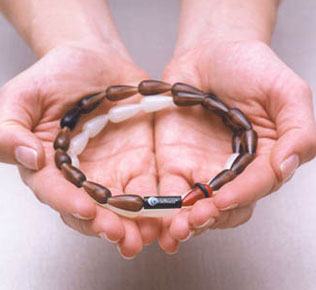 A variation of the calendar method, the Standard Days Method (researched and developed by the Institute for Reproductive Health at Georgetown University) can be used by women who typically have cycles between 26 and 32 days long. In conjunction with this method, color-coded fertility beads called CycleBeads (or digital versions) are used to help you determine when your chances are best to conceive on days 8 through 19, as noted by the white beads.
A variation of the calendar method, the Standard Days Method (researched and developed by the Institute for Reproductive Health at Georgetown University) can be used by women who typically have cycles between 26 and 32 days long. In conjunction with this method, color-coded fertility beads called CycleBeads (or digital versions) are used to help you determine when your chances are best to conceive on days 8 through 19, as noted by the white beads.
Ovulation Microscopes
 Who would’ve thought that saliva and plants have something in common? Sounds weird, but it’s true. Estrogen levels increase around ovulation and can be noticeable in dry saliva by forming a fern-like, or crystal (similar to frost on a windowpane), pattern. Again … strange, but true.
Who would’ve thought that saliva and plants have something in common? Sounds weird, but it’s true. Estrogen levels increase around ovulation and can be noticeable in dry saliva by forming a fern-like, or crystal (similar to frost on a windowpane), pattern. Again … strange, but true.
How can you see this pattern? You can observe it under a small lipstick-shaped microscope. Take a swab of saliza from under your tongue, and use the microscope to view it.
Keep in mind that the fern-shaped pattern doesn’t appear for all women (though it can appear for some men!), and it might not appear consistently, or it may even appear outside of your fertile time period. Other everyday activities can disrupt ferning, too, including eating, drinking, and brushing teeth. The test is best done within the 5-day range of ovulation (including two days before and two days after).
Ovulation Kits
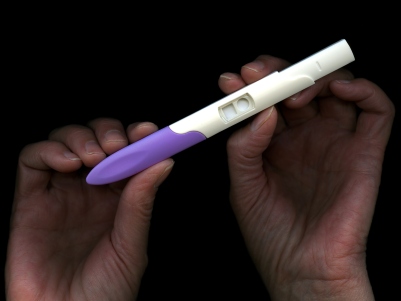 Over-the-counter ovulation tests help provide a sure thing when you don’t want to guess or calculate when you’re ovulating. Says Dr. Copperman: “In general, biochemical markers [such as detecting luteinizing hormone (LH)] are probably more reliable than [ovulation] symptoms or even temperature spikes.” In your body, LH and estrogen levels increase around ovulation. LH, specifically, triggers your body to release an egg, so the surge occurs 1 to 1.5 days before ovulation occurs.
Over-the-counter ovulation tests help provide a sure thing when you don’t want to guess or calculate when you’re ovulating. Says Dr. Copperman: “In general, biochemical markers [such as detecting luteinizing hormone (LH)] are probably more reliable than [ovulation] symptoms or even temperature spikes.” In your body, LH and estrogen levels increase around ovulation. LH, specifically, triggers your body to release an egg, so the surge occurs 1 to 1.5 days before ovulation occurs.
How to ovulation kits/predictors work? They detect a surge in LH and a type of estrogen (which some tests also measure) to precisely reveal when you when you’re ovulating. They’re accurate 9 times out of 10 when instructions are carefully followed, which involves dipping the test stick in your urine or adding your urine to the stick.
Fertility Monitors
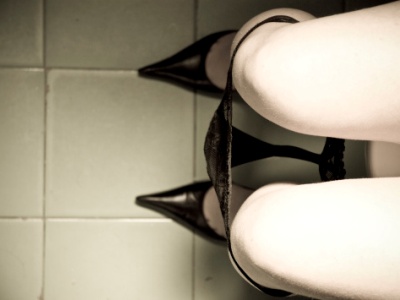 If you’re looking for an all-in-one device, a fertility monitor might be for you, because it can track your cycle month-by-month, read urine tests for reproductive hormone levels, may even have sensors for temperature and vaginal readings, and more. Adds Dr. Copperman: “There are a variety of fertility monitors, but in general, they incorporate more data and can be more helpful, especially in patients with slight cycle irregularity.”
If you’re looking for an all-in-one device, a fertility monitor might be for you, because it can track your cycle month-by-month, read urine tests for reproductive hormone levels, may even have sensors for temperature and vaginal readings, and more. Adds Dr. Copperman: “There are a variety of fertility monitors, but in general, they incorporate more data and can be more helpful, especially in patients with slight cycle irregularity.”
There are also special fertility monitors that measure electrolytes in saliva, which are affected by hormonal changes, and chloride in sweat, which fluctuate during the menstrual cycle.
Do you need these additional tests? “I think that for most women, the LH kit and calendar will be adequate, but adding some of the extra markers may help pinpoint ovulation,” says Dr. Copperman.
